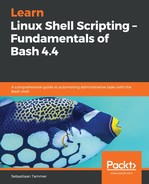In this chapter, we discussed four text editing tools, divided into two types: GUI-based editors (Atom and Notepad++) and command-line editors (Vim and GNU nano), before showing how to use these tools together.
Atom is a powerful text editor that can be configured exactly how you want . By default, it has support for many different coding languages, including shell. It also comes with Git and GitHub integration. We also briefly discussed Notepad++. While not as powerful as Atom, it is also suitable for our purposes, as it is basically an enhanced Notepad with all the important features for shell scripting.
Vim and nano are the two most popular Linux command-line text editors. We have learned that while Vim is very powerful, it is also harder to learn than nano. However, learning how to properly use Vim will speed up many things you do on a Linux system and is a very valuable skill to have. For a great hands-on introduction to Vim, go through the vimtutor. Nano is much easier to use, as it more closely resembles the WYSIWYG editing style also found in Microsoft Word and Notepad.
We ended the chapter with an example of a shell scripting journey. We gave a brief overview of how to use GUI-based editors in combination with command-line editors.
The following commands were introduced in this chapter: vim, nano, and ls.
